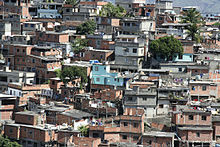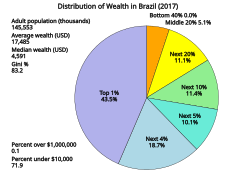Social issues in Brazil

Brazil ranks 49.3 in the Gini coefficient index, with the richest 10% of Brazilians earning 42.7% of the nation's income, the poorest 34% earn less than 1.2%.[1]
According to PNUD, in 1991, 99.2% of the municipalities had a low/very low HDI; but this number has fallen to 25.2% in 2010. On the other hand, the number of municipalities with high/very high HDI jumped from 0.2% in 1991 to 34.7% in 2010.[2] In 2012, the Brazilian HDI was 0.730, ranking 83rd worldwide and considered high.
Poverty[]



Poverty in Brazil is most visually represented by the favelas, slums in the country's metropolitan areas and remote upcountry regions that suffer with economic underdevelopment and below-par standards of living. In Rio de Janeiro, about a fifth of its population of six million live in several hundred favelas, situated on steep, neglected land largely beyond the control and services of city authorities.[3] An attempt to mitigate these problems is the "Fome Zero" program launched by then-President Luiz Inácio Lula da Silva in 2003. Part of this is "Bolsa Família",[4] a cash transfer program that gives money to impoverished families under the condition that they keep their kids vaccinated and in school.
The Lula administration (2003–2011) reduced 9.8% the rate of poverty based on labor income during June 2002 and June 2006 according to Fundação Getúlio Vargas. In June 2006, the rate of extreme poverty was 18.57% of the population.[5]
The rate of poverty is in part attributed to the country's economic inequality. Brazil ranks among the world's highest nations in the Gini coefficient index of inequality assessment. A study on the subject [6] shows that the poor segment constitutes roughly one third of the population, and the extremely poor make out 13% (2005 figures). However, the same study shows the income growth of the poorest 20% population segment to be almost in par with China, while the richest 10% are stagnating.
Reduction[]
The Brazilian federal government has also implemented and expanded in the last years major subsidy programs, such as Bolsa Família and Fome Zero, for families deemed to be in need of assistance.
Crime in Brazil[]

Brazil has serious problems with crime. With roughly 23.8 homicides per 100,000 residents,[7] muggings, robberies, kidnappings[8] and gang violence[9] are common. Police brutality and corruption are widespread.[10][11] In response, the Brazilian government established the National Public Security Force (FNSP) in June 2004 by the Ministry of Justice, to act in situations of emergency, in times of crisis.
More than 800,000 people were murdered in Brazil between 1980 and 2004.[12] There were a total of 63,880 murders in Brazil in 2018.[13]
Education[]


Public education in Brazil is free at all levels.[14] Primary education is compulsory as per the article 208 of the Brazilian Constitution.
Most primary schools are constitutionally maintained either by municipalities or the states. Both entities are obliged to apply at least 25% of their budgets in education. Since economic disparities exist between states, richer states and cities have more money to deliver quality education, whereas in the poorer cities and States the education will be generally of lower standards.
School non-attendance by absence and malnutrition is one of the biggest educational problems in Brazil. Work under the age of 16 is forbidden by law, however Brazil has many cases of child labor. Children from large poor families start working from the age of 10 in order to help their parents, despite the law of compulsory education between the ages of 10 and 14. Other reasons for school non-attendance are the lack of sufficient school places and the high examination failure rate. Malnutrition also materially affects the intellectual development of children, giving them little chance of adapting to an educational environment.
The standards of primary and secondary public education have been falling over the past decades. Since the country invested little in education, public education's standards dropped and the middle class moved their children to private schools. Nowadays, practically all the middle class sends their children to private schools. Costs may vary from as little as R$600 (US$240) p.a. in smaller cities to R$30,000 (US$17,000) p.a.[15] in São Paulo or Rio de Janeiro.
The situation has been improving over the past few years thanks to two official projects: Bolsa Escola, by which parents who keep their children in school and with good health receive a small allowance, and FUNDEF, by which municipalities receive federal funds in accordance to the number of children enrolled. Bolsa Escola was a conditional cash transfer (CCT) program that offered mothers in poor households a monthly stipend if their children ages 6 to 15 attended school on a regular basis. The program was implemented across all of Brazil between the years 2001 and 2003, until it was folded into the broader Bolsa Família program.
Brazil is participating of the One Laptop Per Child project,[16] aiming at providing low cost laptops to poor children in developing countries, but the program is moving slowly.
Infant mortality[]
Table 1. Infant Mortality Rates by Regions of Brazil (per 1,000 live births)
| Regions | 1970 | 1980 | 1991 | 2000 |
|---|---|---|---|---|
| North | 180.07 | 135.12 | 48.93 | 41.14 |
| Northeast | 111.71 | 71.01 | 74.35 | 64.25 |
| Southeast | 97.34 | 61.08 | 34.42 | 27.46 |
| South | 80.95 | 51.69 | 28.93 | 23.59 |
| Center West | 92.22 | 59.59 | 38.60 | 31.00 |
| Brazil | 123.55 | 85.30 | 49.45 | 34.08 |
Source: Fundação IBGE, Census of Population, 1991 and 2000.
Housing[]
Rapid urbanisation and population growth have caused many problems in developing cities. As cities grow too rapidly, resources are not able to keep up with the swelling population. Housing is one of the major problems many developing cities are facing today. Migrants who cannot afford proper housing are forced to build temporary housing without proper utilities. These settlements are known as favelas. With a population of 12.7 million people, Rio de Janeiro is the second largest city in Brazil.[17] With a combination of push and pull factors, urban migration to Rio account for over 65% of population growth. This has led to a serious shortage of proper housing.
Brazil's housing deficit is around 7 million units. "Housing deficit" here refers to the number of shelters which do not have adequate conditions to be habitable, plus the number of housing units that need to be built to shelter all families who currently lack one and, as a result, share a shelter with another household in over crowded conditions.[18]

Many city dwellers build their own houses in shanty towns with scrap materials such as iron sheets and wood. Basic sanitation, water, electricity and sewage system may not be available, thereby leading to a spread of diseases. Such units are also overpopulated and located in areas not fit for residential use (such as flood zones, areas subject to land slides, public rights-of-ways, etc.) and need to be replaced or evicted. The favelas are not built according to any laws or safety regulations, and thus residents are constantly at risk of being killed in landslides or fires.[19]
As it stands, it has been identified that 84% of the housing deficit in Brazil is concentrated on families earning less than three times the minimum wage (a minimum wage is around $360 per month).[20] Caught in the poverty cycle, families' incomes are structurally limited and as a result they are unable afford proper housing.
An example of one such favela in Brazil is Rocinha. Rocinha is one of the largest favelas in Brazil. Located in the southern area of Rio de Janeiro, it is built on a steep hillside overlooking the city. Although official datasets are hard to obtain, it is believed that over 150,000 people reside there.[21]
This rapid rate of illegal occupation of urban land has led to serious problems not only for the residents, but also for the entire city at large as well as the city's landscape and the natural environment of the surrounding areas.[22]
See also[]
- May 2006 São Paulo violence
- July 2006 São Paulo violence
- Social apartheid in Brazil
- Racism in Brazil
- Human rights in Brazil
References[]
- ^ "Pnad 2008 - Atualidades - UOL Educação". educacao.uol.com.br. Retrieved 3 April 2018.
- ^ "Archived copy". Archived from the original on 2014-03-13. Retrieved 2014-06-14.CS1 maint: archived copy as title (link)
- ^ H., Hunt, Michael (2015-06-26). The world transformed : 1945 to the present. p. 443. ISBN 9780199371020. OCLC 907585907.
- ^ World Bank website, The Nuts and Bolts of Brazil's Bolsa Família Program: Implementing Conditional Cash Transfers in a Decentralized Context, IBRD 2007 paper, retrieved June 8, 2007
- ^ Fundação Getúlio Vargas. FGV - Gráfico da Miséria (PDF). Retrieved 2007-06-12.
- ^ Ricardo Paes de Barros, Mirela de Carvalho, Samuel Franco, Rosane Mendonça: A Importância da Queda Recente da Desigualdade para a Pobreza [1]
- ^ "No end of Violence". The Economist. April 12, 2007. Retrieved 2007-11-18.
- ^ BBC News "Brazil's evolving kidnap culture" retrieved 2007-08-24
- ^ BBC News "Gang violence grips Brazil state" retrieved 2007-08-22
- ^ Human Rights Report "Police brutality in urban Brazil" retrieved 2007-08-24
- ^ Amnesty International "Violence in Brazil" retrieved 2007-08-24
- ^ "BRAZIL: Youth Still in Trouble, Despite Plethora of Social Programmes Archived 2013-10-29 at the Wayback Machine". IPS. March 30, 2007.
- ^ "A Year of Violence Sees Brazil's Murder Rate Hit Record High". The New York Times. 10 August 2018.
- ^ "Schools and Education in Brazil". brazilbrazil.com. Retrieved 3 April 2018.
- ^ "Folha Online". www1.folha.uol.com.br. Retrieved 3 April 2018.
- ^ "One Laptop Per Child gains ground". theregister.co.uk. Retrieved 3 April 2018.
- ^ Brinkhoff, Thomas. "City Population". Retrieved 13 February 2012.
- ^ Carlos, Arenas. "Analyzing the Housing Deficit". Retrieved 13 February 2012.
- ^ Abahlali baseMjondolo. "Terrible Shack Fire in Kennedy Road". Archived from the original on 14 February 2012. Retrieved 13 February 2012.
- ^ Flavio, Malta. "Low Income Housing in Brazil: The Case of São Sebastião". Retrieved 13 February 2012.
- ^ Internet Geography. "Favela Case Study - Rocinha". Retrieved 14 February 2012.
- ^ Maricato, Erminia. "Poverty and some reasons for hope" (PDF). Retrieved 14 February 2012.
- Social issues in Brazil
- Poverty in Brazil